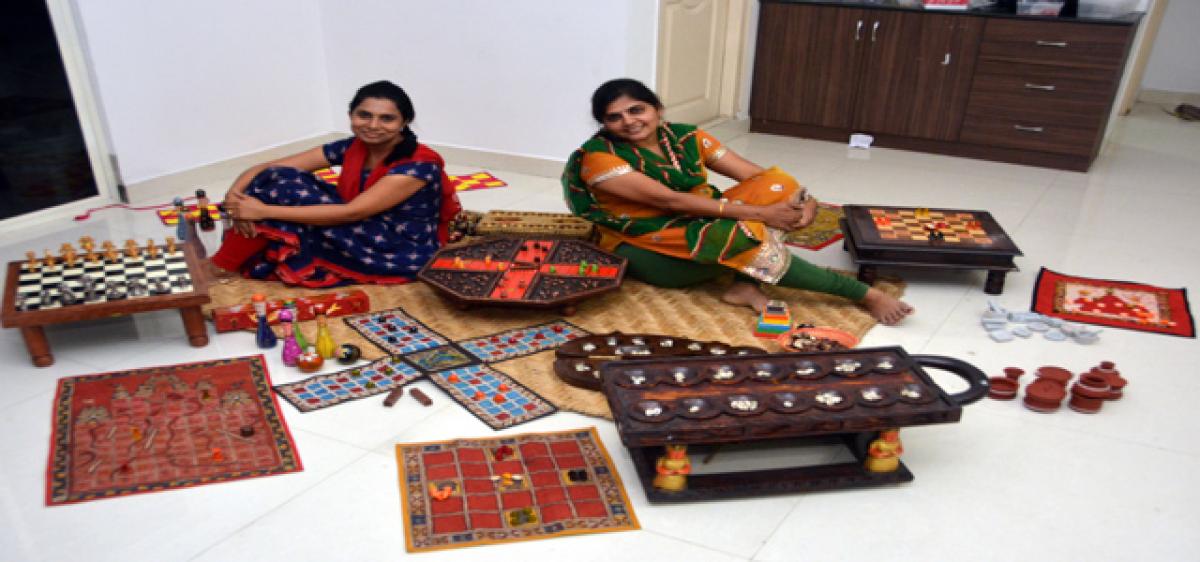Live
- DEO suspends teacher accused of sexual assault
- PM ‘cursing’ Congress out of despair: Maharashtra Cong Chief
- Applications are invited for Junior Colleges Scheme District Scheduled Castes Development Officer Ramlal
- A nomination was filed on the second day for the Nagar Kurnool parliamentary seat
- SP Gaikwad inspected the Telangana Amarnath Saleswaram Jatara yatra arrangements
- Rahul Gandhi's decision to contest from Wayanad shows 'lack of confidence': BJP President Nadda
- IPL 2024: Delhi bowlers will go after all of SRH’s top-order batters, says head coach Ricky Ponting
- At Amroha rally, PM Modi sends out ‘meaningful’ message for Muslims and Hindus
- Tripura records highest 79.83 pc voter turnout in Northeast
- The government has to clear the confusion
Just In

Board games were an intrinsic part of ancient Indian culture, with history and mythology replete with tales of Lord Siva and his consort Parvati playing Pacheesi, the Pandavas losing Draupadi over a game of dice and the Moghuls known for their fine living amusing themselves with a game of Shatranj (chess).
Board games were an intrinsic part of ancient Indian culture, with history and mythology replete with tales of Lord Siva and his consort Parvati playing Pacheesi, the Pandavas losing Draupadi over a game of dice and the Moghuls known for their fine living amusing themselves with a game of Shatranj (chess).
Adi Shankaracharya is said to have played a game of dice with goddess Meenakshi in the Madurai temple and transformed the shakthi from Tamas (negative) to Sathvik (positive) emotion with the Sri Chakra being designed by replacing the “beejaksharas” during the game.
The Mysore Maharaja Krishna Raja Wodeyar 111 is credited with creating some of the most complex board games that could keep one occupied for years. One of his most complex games ‘Navagraha Pagade Ata’ has Indian astrology and astronomy incorporated into it.
Two friends from Hyderabad Archana Reddy and Sangeeta Rajesh came up with a unique concept of reviving these ancient games that have vanished from public memory after months of research, working with artisans in Andhra Pradesh, Tamil Nadu and Karnataka and creative spells that included innovation and expansion of ideas.
‘Good old games,’ is their effort to recreate the magic of the past for the younger generation lost in the melee of ‘virtual games’ and expensive gadgets and unaware of our rich legacy.
“I had been looking for practical games that would inculcate a team spirit among children and kindle their interest and my friend Archana and me, who share common interests came upon the idea of revival after a chance conversation,” says Sangeeta Rajesh, who also runs a play school ‘Smiles’ in Himmayat Nagar, Hyderabad.
“We delved into the past to remind parents of our rich heritage, which they can introduce to the kids,” Archana Reddy adds.
After the success of an exhibition they put together showcasing these rare games in April last year, the duo is holding another two-day exhibition at Saptaparni, Hyderabad this weekend.
Board games made of hand-woven, embroidered and printed fabric, jute, brass and rosewood, tiny kitchen sets, cowries, shells and pebbles, pacheesis of different varieties including chowkis, and Vamanaguntalu (played by two players on a wooden board with 14 pits) presented beautifully and artistically are a part of their collection and instantly cast a spell.
For a generation that has spent languid summer afternoons playing these games with cousins and friends it is bound to evoke nostalgia, and for the new generation growing up on virtual games often played alone it is an exciting new world of possibilities.
Pacheesi, a cross and circle board game that originated in ancient India has been described as the ‘National game of India’ and is played on a board shaped like a cross. A player’s pieces move around the board based upon a throw of six or seven cowrie shells, with the number of shells resting with aperture upwards indicating the number of spaces to move.
The name is derived from the word “Pachees” meaning twenty-five, which is the highest score that could be thrown with cowrie shells. There are other versions of this game, where the largest score that can be thrown is thirty. The duo has created 8 to 10 varieties of pacheesi with hand printing, embroidery, Chowki version, rosewood and on copper plates.
Puli-meka (Goat and tiger), which has one player controlling three tigers and the other shepherding the goats is an interesting game with one player controlling the tigers on the hunt and the other on a mission to protect the flock.
Vamanaguntalu with an interesting fish shaped rosewood box is another game that children would be interested in. Snakes and ladders called ‘Kailasam’, Gacchikayalu , the humble catapult, marbles and other forgotten games find a place of pride in their collection.
“Just watching a top spin can be such an invigorating experience for both kids and adults,” says Archana reiterating that the whole endeavour is a work of passion.
“We are going to hold exhibitions like these and do not plan to go for mass production. We hope to increase awareness among parents, teachers and children about our beautiful legacy,” says Sangita.
These games can create a bond between families, aid mathematical skills, dexterity, memory, hone logical and strategic thinking and even keep Alzheimers and dementia at bay and are therefore useful to people of all ages. ‘Good old games’ is a worthy endeavour to reconnect to our past and take it forward.

© 2024 Hyderabad Media House Limited/The Hans India. All rights reserved. Powered by hocalwire.com







